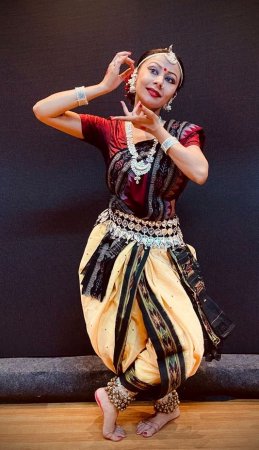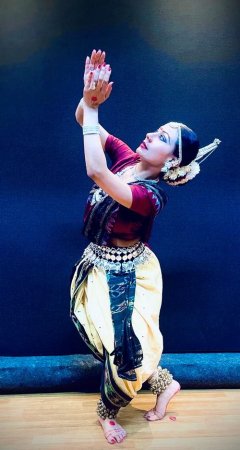
|   |

|   |
Traditional Odissi in contemporary global contexts: An exceptional creative approach with a resonating impact - Srabani Basu e-mail: odissi.srabani@gmail.com March 7, 2025 Introduction: "Tradition in Context" - a phrase that appears as a pertinent subject in itself; to be explored amidst the rapid sociocultural, economic and technological evolvement of humanity in today's time. Having said that, here I write about my experience of an inspiring art production that addresses contemporary contexts through reinventing India's rich heritage of Odissi dance, aptly titled as 'Tradition in Context' (choreographed by Dr. Rohini Dandavate and performed by Dr. Kaustavi Sarkar). It was premiered in India on 19th January 2025 in the city of Mumbai. Odissi is a classical dance form in India, that has been preserved as a cultural heritage with its roots tracing back to over 2000 years as per archeological evidence. While the structural essence and technicalities of this dance form is derived from Natyasastra ('the text of dramaturgy' written between 200 BCE and 200 CE) and Abhinayadarpana ('The mirror of gestures' written between the second and fifth centuries AD), Odissi has been restructured post India's independence from British rule in the 20th century with a defined repertoire largely inspired by ancient Indian literature and mythology. I as an Odissi practitioner, also balancing a professional career in the corporate world of software services industry that typically aims towards a future of artificial intelligence, machine learning and technological advances, have always come across a sense of disconnect to derive a relevance with our present life through bridging the gap between these two worlds of past with a niche artistic tradition and cultural heritage of humanities, and future with a fast-changing globalized society of massive scientific progressions. Attending the 'Tradition in Context' concert addressed many aspects of this personal quest of mine, in a positive, delightful and enriching manner. Structure of presentation: 'Tradition in Context' is an idea conceived by senior Odissi exponent and scholar Dr. Rohini Dandavate from the viewpoint of an Indian immigrant artiste residing in the US for over three decades, with an aim to cultivate intercultural curiosity engaging diverse audiences through the medium of art. In the process of building this production during the COVID pandemic, the intercontinental creative collaboration primarily happened in the virtual mode with dancer Dr. Kaustavi Sarkar (Dance, North Carolina-USA), Dr. Anirban Bhattacharjee (Music, New Delhi-India) and G. Ramprasad (Percussion, Mumbai-India), all of them being accomplished artists in their respective fields. The presentation consisted of dance and dialogue designed in two segments - the first one showing three consecutive acts on 'Fire', 'Trigger' and 'Enigmatic Bliss (A Question)' whereas the second segment 'Ek Azad Pankh' brought forth the choreographic interpretation of a poem by Uday Dandavate depicting the journey of self-exploration through the metaphor of an unstuck feather.  Dr. Kaustavi Sarkar Item detail: Fire: The first presentation personifies Fire (Agni) with its constructive and destructive powers. The idea behind this thematic act, sprouted in the mind of Dr. Dandavate as she personally witnessed the dreadful impact of wildfires after moving to California. The initial section of the item portrays an integral part of traditional spirituality of Odissi where the verses are referred from Agni Purana and the dancer depicts the birth of fire with the ritualistic elements around it. It further elaborates the fostering aspects of Fire as a life-giving source of Sun, through creation of a thriving environment that eventually burns everything down due to the reckless greed of mankind. This piece marks to be a dedication to the devastation caused by the California wildfire. The melodious music composition of 'Fire' by the legendary musician Ashit Desai, is set to Ragamalika (a combination of various ragas from the Hindustani classical music) to enable the depiction of a wide spectrum of emotions ranging from devotion, elation and beauty of nature to the sore feeling of loss and damage. Trigger: The second act Trigger is deeply impactful, that depicts gun violence in the US resulting in unfortunate death of innocent school children, the sacrifice of their teachers' lives and anguish of their parents. It persuades the audience to reflect on the increasing menace of shootings and raises a significant question on this tragic social issue which is quite preventable. This piece is primarily expressional that commences with the note of solemn offering to the lives lost followed by a detailed enactment of the gruesome event. The classroom atmosphere is designed beautifully with the frisky mischief of the young students while the teacher is shown lecturing as well as admonishing them. The mood shifts radically with the sudden appearance and the cruel rampage by the shooter, the helplessness of the teacher and lastly the fall of all the innocent lives. This piece explores an interesting perspective of portraying the unfulfilled aspirations and potentials of the youngsters to become basketball players / visual artists / hula hoop gymnasts / scuba divers etc. all of which got shattered in an untimely manner. The item ends on a note of prayer for peace, with an aim to invite contemplation towards introducing policies for gun control as a prevention of such nonsensical mass murders. The music of 'Trigger' incorporates both rhythmic sequences and various instruments from the Indian classical tradition to tastefully link with the primary theme (sthayi bhava) of offering, irreversible loss, pain, and prayer, to naturally flow through the elaboration of transitory acts (sanchari bhava) of classroom environment, the event of shooting and dream sequences of the children. Enigmatic Bliss: The third piece of the production traverses through the dichotomy in our lived experiences as humans. Influenced by a song of poet Rabindranath Tagore, 'Bichitro Anondo', a phrase literally translated as 'Enigmatic Bliss', this item closely associates to a philosophical genre yet fairly is in touch with the practical aspects of environmental injustice, pandemic and immigration policies. The movements and expressions of the dancer lyrically intertwines the contrast of 'Amrito-Mrityu' meaning eternity-death, 'Timir-Jyoti' meaning darkness-light, 'Shok-Shantona' meaning despair-consolation and 'Milana-Bichheda' meaning union-separation. The act initiates with blissful mood by weaving the beauty of nature through dancing peacocks, blossoming trees, fragrant flowers, buzzing bees, flying birds, the free-flowing streams with fishes swimming within. This joyous image then crashes down to death and sorrow by the horrifying event of pandemic, at one instance of which even the holy Ganges was seen with floating corpses. It then moves on to the idea of showing creation through the energy of Sun and the soothing beauty of twinkling stars of the night sky. The final segment of this piece focuses on the conflict of union and separation through the theme of political unrest and migration problem in the US where children are taken away from their mothers in the border. The unbearable agony of the mother as well as the insecurity and trauma of the child is humanely woven in the choreography with an impeccable execution by Dr. Kaustavi Sarkar. Driven by a feeling of helplessness in comprehending this peculiar duality of life experiences through different circumstances, this piece imagines all these events to be a poet's play and concludes with a question on how to unfold this strange play of enigmatic bliss. The music composition of 'Enigmatic Bliss' is an amalgamation of the original Tagore song harmonically embellished in raga Mishra Saarang, and the rhythm set to taal Triputa/Teyora (7 beats time cycle). Ek Azad Pankh: The final act is based on a poem 'The unstuck feather', written by Uday Dandavate, husband of Dr. Rohini Dandavate. As explained by Uday himself, the inspiration behind this poem was his fleeting encounter with a feather that was drifting atop a mountain in San Francisco. He was unable to catch the feather and watched it floating away in the soothing breeze. He described this moment as an epiphany sparking his imagination and reflection on his own life. During the choreographic process of this piece, Uday translated the poem in Hindi naming it 'Ek Azad Pankh' in which all the collaborators brought elements of their personal journeys. This item explores the allegory associated with a feather which doesn't want to be captured or stuck with a flock and always desires to be free flowing. The theme also touches down upon the various meanings or interpretations of feathers across cultures such as universal love, spiritual liberation, freedom, hope. At one point, it symbolizes divinity through a guardian angel where the dancer shares a personal moment of connection with her mother. This entire act is a blend of selected verses from the poem, syllabic beats of the percussion and arrangement of swaras to convey the fundamental message of independence of an individual's mind and heart through the metaphor of a feather, that also signifies resilience in navigating through life's journey.  Dr. Kaustavi Sarkar Choreographic elements: The choreography of the items is based in traditional Odissi vocabulary exploring the fundamental bhangis (postures) i.e. Samabhanga, Abhanga, Chouka, Tribhanga and various movement patterns, ranging from the basic step exercises to expanding further in complex and advanced tapestry of gestures as well as expressional features. The unconventional yet wonderful attempt of using Odissi movements to depict the game of basketball and hula-hoop gymnastics in the second act 'Trigger', deserves a special mention. While the depiction of spirituality, joyousness of nature and enormous devastation in the first act 'Fire' profoundly uses the element of abhinaya, 'Enigmatic Bliss' follows the structure of Saabhinay Pallavi through demonstration of a seamless blend of pure dance and expression elevating the depth of Odissi technicalities to unravel Tagore's eternal creation. Other significant highlights: The thoughtful composition of music based on Hindustani classical melody by Dr. Anirban Bhattacharjee and rhythmic experiments by G. Ramprasad melded organically with the themes of the items. Uday Dandavate has designed the digital background with still images and video clips which not just enhances the visual delight but effectively facilitates comprehensibility in connection between the poignant elaboration of the contemporary contexts and the traditional Odissi movements, for multicultural audiences. Conclusion: Overall, this production is a powerful manifestation of Dr. Rohini Dandavate's choreographic excellence with a distinctive outlook towards interpreting 'Tradition in Context' and Dr. Kaustavi Sarkar's captivating dexterity as an Odissi artiste, that left a lasting impression on the viewers. Look forward to experiencing their future work with various such exceptional approaches which is essential in reinventing the timeless relevance of ancient Indian art and philosophy.  Srabani Basu is an Odissi artiste with an academic background in Computer Science & Engineering. She collaborates with NGOs to conduct dance workshops for underprivileged school children. She has achieved international recognition through her recent paper 'Indian classical dance: A study of its therapeutic exploration' published in 'Journal of Applied Arts and Health' (Volume 15, Issue 2, July 2024), an acclaimed peer-reviewed journal run by UK-based publishing house 'Intellect Discover'. |